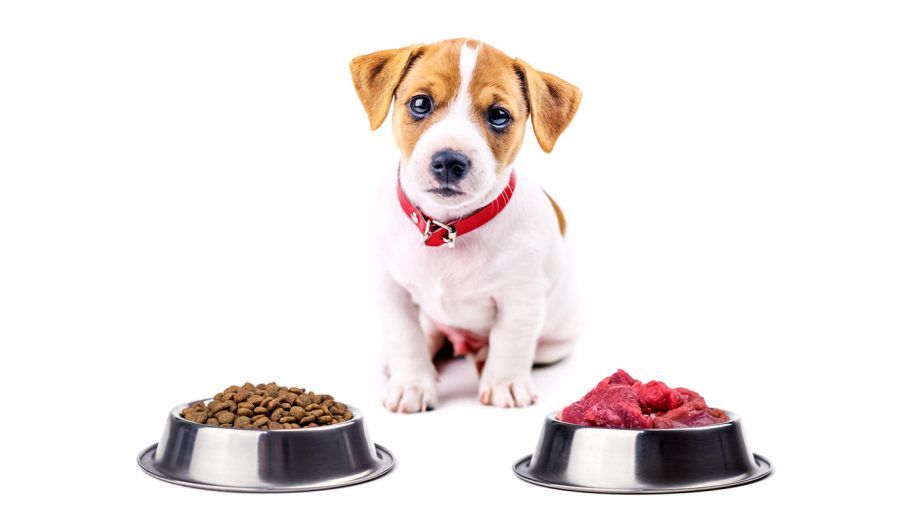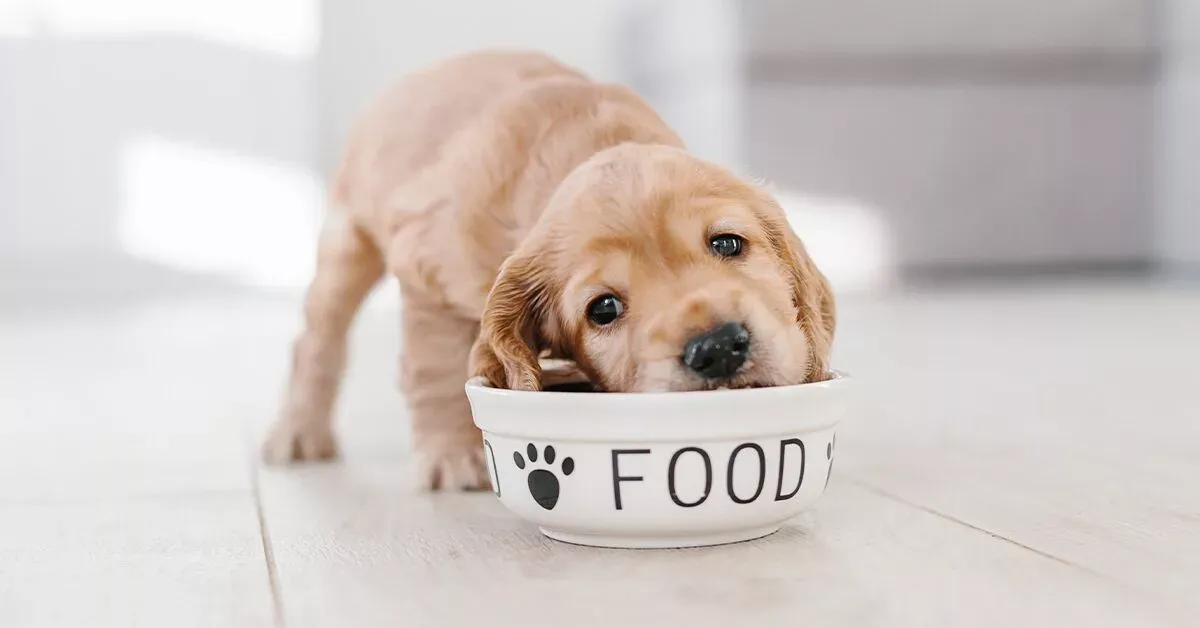Welcoming a new puppy into your home is an exciting experience, but it comes with responsibilities—chief among them, ensuring your furry friend gets the right nutrition. The question on every new pet owner's mind is, "How much should I feed my puppy?" Let's delve into the intricacies of puppy nutrition to provide you with a comprehensive guide.

Understanding Puppy Nutrition Basics
So, you've got a new four-legged family member, and now you're faced with the responsibility of making sure they grow up to be a happy, healthy dog. The key to a thriving puppy starts with understanding the basics of their nutrition.
Age-specific Nutritional Needs
Puppies are a bit like tiny, furry superheroes in training, and they need the right fuel to power their growth and antics. The first step in decoding puppy nutrition is acknowledging that their needs evolve as they age.
Protein Power: Imagine protein as the superhero cape for your pup's muscles, organs, and tissues. Look for puppy foods with quality protein sources like chicken or lamb.
Healthy Fats for Brain Power: Yes, you're feeding their brains! Healthy fats, like those found in fish oil, are like brain food for your little Einstein in the making.

Carbs – Energy for Play: Carbs are the fuel that keeps your pup bouncing around like a little energizer bunny. Opt for whole grains to keep their energy levels steady.
Vitamins and Minerals – Tiny but Mighty: These little guys play a big role in your puppy's overall health. From a shiny coat to a robust immune system, they're the unsung heroes of nutrition.
Importance of Balanced Diets
Now that you know what your puppy needs, it's time to play chef and create a well-balanced diet. Think of it as crafting a culinary masterpiece for your furball.
The Art of Balance: Balancing proteins, fats, carbs, vitamins, and minerals is like conducting a symphony for your pup's taste buds and health.
Consult with Your Vet: Your puppy is unique, and so are their needs. Before you become a pet nutrition expert, consult with your veterinarian for personalized advice.
There you have it – the basics of puppy nutrition. It's not rocket science, but it's definitely a recipe for a healthy, happy pup!
Choosing the Right Puppy Food
Now that you've mastered the art of puppy nutrition, it's time to hit the store and pick out the perfect puppy chow. But with aisles filled with options, where do you start?
Factors to Consider When Selecting Puppy Food
Puppy food shopping isn't just a grab-and-go situation. There are a few key factors to keep in mind when making this important decision.
Age Matters: Look for food specifically labeled for puppies. It's like getting a VIP pass to the nutrition party tailored for your little one.
Size and Breed Considerations: Puppies come in all shapes and sizes. Match the food to your pup's expected adult size for a perfect fit.
Check the Ingredients List: Just like reading the ingredients in your food, scrutinize your pup's potential meals. High-quality protein should be the star, and steer clear of mysterious fillers.
Allergies and Sensitivities: Some pups are more sensitive than others. If your furball starts scratching or showing signs of tummy troubles, it might be time to explore alternative food options.
Reading and Understanding Food Labels
Deciphering food labels is like having a secret code to unlock the mysteries of puppy nutrition. Time to become a label-reading pro!
The First Ingredient Rule: The first ingredient listed is the main event. If it's a top-notch protein source, you're on the right track.
Guaranteed Analysis – More Than Just Numbers: It's not just percentages; it's a sneak peek into what makes up the food. Compare it to your puppy's needs.
Avoiding Fillers and Additives: Keep it real – minimal fillers, no artificial colors, and preservatives. Your puppy deserves the good stuff.
Consulting Your Veterinarian
Your vet isn't just there for vaccinations; they're your partner in pet parenthood. Get their take on your puppy's food choice.
A Tailored Approach: Your vet can help you tailor your puppy's diet to their unique needs. They're like your nutrition consultant but for the furry family members.
Monitor and Adjust: Once you've made a choice, it's not set in stone. Keep an eye on how your pup responds, and be ready to adjust if needed.
Armed with this knowledge, you're ready to conquer the puppy food aisle. Your pup's bowl is about to become a haven of nutrition and tail-wagging delight!
How Often Should I Feed My Puppy?
Now that you've picked the perfect puppy chow, it's time to get the feeding schedule down. How often should you fill that bowl? Let's dive into the world of puppy dining habits.

Establishing a Feeding Schedule
Puppies are creatures of habit, and a routine is your best friend. Let's break it down by age group.
Puppies Under 6 Months: These little balls of energy need three meals a day. It keeps them fueled for their frequent play and rapid growth.
Puppies 6 to 12 Months: As they grow, you can cut back to two meals a day. It aligns with their changing metabolism and prepares them for the adult dog dining routine.
Adult Dogs: Around the one-year mark, most dogs transition to two meals a day. It's like the canine version of brunch and dinner.
Adjusting for Different Breeds and Sizes
Not all puppies are created equal, and their feeding needs can vary based on their size and breed. Consider these factors for a tailored approach.
Small Breeds: These little guys often have higher metabolisms, so more frequent meals may suit them well. Keep an eye on their weight and energy levels.
Large Breeds: Big dogs have big nutritional needs. Consult your vet for advice on feeding schedules that support their specific requirements.
Consistency is Key
Whether it's three meals or two, the magic word is consistency. Same time, same place – it's like canine dinner and a movie.
The Scoop on Scooping: Measure out their food to avoid accidental overfeeding. It's like portion control for your pup.
Treats and Extras: Those puppy-dog eyes are hard to resist, especially when treats are involved. Just be mindful of how they factor into the overall daily caloric intake.
Portion Control for Puppies
Alright, you've mastered the art of choosing the perfect puppy food, but now comes another crucial piece of the puzzle – portion control. It's like being the chef and the nutritionist rolled into one, ensuring your pup gets the right amount to keep them happy and healthy.
Avoiding Overfeeding and Underfeeding
Think of portion control as finding the Goldilocks zone for your puppy's meals – not too much, not too little, but just right. Overfeeding can lead to a pudgy pup, while underfeeding might leave them lacking the energy they need for play and growth.
Monitoring Puppy Weight and Growth: Keep a close eye on your puppy's weight and growth rate. If they're putting on too many pounds or lagging behind, it might be time to adjust those portions.
Transitioning to Adult Dog Food
Puppies grow up faster than you can say "fetch," and that means transitioning them from puppy food to adult dog food. It's like upgrading them from the kiddie table to the adult table, but in kibble form.
When and How to Switch to Adult Dog Food
Around the one-year mark, your puppy is ready for the big leagues – adult dog food. But how do you make this transition smooth for their sensitive tummies?
Gradual Transition Tips: Imagine it as a culinary journey. Mix a bit of the new adult food with their puppy food, gradually increasing the ratio. This helps their digestive system ease into the new menu without any tummy turmoil.
Common Puppy Feeding Mistakes to Avoid
Nobody's perfect, and that includes puppy parents. But being aware of common feeding mistakes can help you dodge pitfalls and ensure your pup thrives.
Identifying and Rectifying Common Errors
We've all been there – maybe a few too many treats, or forgetting to adjust their portions as they grow. It happens. The key is to identify these slip-ups and course-correct.
Consulting a Veterinarian for Guidance: If you're unsure whether you're making the right feeding choices, don't be shy about consulting your vet. They're like the dog nutrition gurus for your furry friend.
Special Considerations for Certain Breeds
Now, let's talk about catering to the unique needs of our furry friends because, let's face it, not all pups are cut from the same cloth. Different breeds come with different characteristics and, you guessed it, distinct dietary requirements.
Unique Dietary Needs of Specific Breeds
Just like people have various dietary preferences, certain dog breeds have specific nutritional needs. For example, a small, energetic terrier might need a different diet compared to a gentle giant like a Great Dane.
Tailoring Nutrition to Individual Requirements: It's not a one-size-fits-all scenario. Larger breeds might benefit from joint support, while smaller ones might need more energy-packed meals. Do your research and tailor your pup's diet to match their breed characteristics.
Homemade Puppy Food vs. Commercial Options
Alright, buckle up because we're entering the territory of homemade puppy food versus commercial options. It's like choosing between cooking up a storm in your kitchen or opting for the convenience of store-bought meals.
Pros and Cons of Homemade Diets
There's a certain allure to whipping up a homemade feast for your pup. It feels personal, like preparing a gourmet meal for a loved one. But, of course, there are pros and cons to consider.
Pros: You have control over the ingredients, and it can be more budget-friendly. Plus, you get major chef points.
Cons: Balancing the nutrients can be trickier, and it requires time and effort. You don't want your pup missing out on essential vitamins because you got too experimental in the kitchen.
Ensuring Nutritional Adequacy with Commercial Options
On the flip side, commercial puppy foods have their own set of perks and drawbacks.

Pros: They're convenient, nutritionally balanced, and save you time. No need to play scientist in the kitchen.
Cons: Some commercial options might contain fillers or additives. Reading labels is crucial here.
Addressing Allergies and Sensitivities
Ah, allergies and sensitivities – the thorn in the paw of many pet parents. But fear not, we're diving into how to navigate these tricky waters.
Identifying Signs of Allergies in Puppies
Puppies can be sensitive souls, and allergies might rear their itchy heads. Keep an eye out for signs like persistent itching, digestive issues, or irritated skin.
Adjusting Diets for Allergic Reactions: If you suspect allergies, it's like playing detective. Adjust their diet by eliminating potential culprits one by one, or consult your vet for a professional opinion.
Treats and Supplements for Puppies
Now, let's talk about the perks of being a puppy parent – treats and supplements. It's like the dessert table of the canine world, filled with goodies to make those tails wag and keep your pup in tip-top shape.
Incorporating Treats into the Diet
Treats are the currency of the doggy world. They're not just for bribery; they're a tool for training, bonding, and the occasional "just because" moment.
Pros of Treats: They're like little bites of motivation during training sessions. Plus, who can resist those puppy-dog eyes when a treat is in the picture?
Cons of Treats: Too many treats can lead to a pudgy pup. It's all about balance. Consider treats as special bonuses, not a main course.
Necessary Supplements for Overall Health
Now, let's dive into the world of supplements – the extra boost your pup might need to shine like the star they are.
Essential Nutrients: Sometimes, your pup's diet might need a little supplementation. This could include omega-3 fatty acids for a glossy coat or glucosamine for joint health.
Consulting Your Veterinarian: Before playing scientist with your pup's diet, consult your vet. They'll guide you on whether your furry friend needs any extra nutritional support.
Ensuring Proper Hydration
Water, the elixir of life! Ensuring your pup stays properly hydrated is like giving them a refreshing sip of vitality every day.
Importance of Water in a Puppy's Diet
Water is more than just a thirst quencher; it's vital for digestion, nutrient absorption, and temperature regulation. It's like the unsung hero of your pup's overall well-being.
Recognizing Signs of Dehydration: Keep an eye out for signs like lethargy, sunken eyes, or sticky gums. If your pup isn't hitting the water bowl as often, it might be time for a hydration check.
Addressing Dehydration: If you suspect dehydration, encourage your pup to drink more water. You can even add a splash of low-sodium broth to entice them.
Monitoring Puppy's Health Through Diet
Your pup's diet is like a nutritional diary, chronicling their well-being. Let's explore how you can decode this diary and keep tabs on their health.
Using Diet as an Indicator of Overall Health
A healthy pup is a happy pup, and their diet is a key indicator. Shiny coat? Regular bathroom breaks? These are signs of a diet doing its job.
Consistency is Key: Stick to a consistent feeding schedule and monitor any changes in appetite, weight, or behavior.
Consulting a Veterinarian: If something seems off, don't play Dr. Google. Consult your vet. They're the Sherlock Holmes of pet health mysteries.
Tips for Picky Eaters
Ah, the saga of the picky eater – a tale known to many a pet parent. If your pup turns their nose up at dinner or gives you the side-eye when presented with a new kibble, you're not alone. Fear not, for we have a few tricks up our sleeves to turn your picky pup into a gourmet enthusiast.

Experiment with Textures and Flavors
Just like us, dogs have preferences. Some may prefer the crunch of kibble, while others fancy the moistness of wet food. Try a mix or experiment with different flavors to pique their interest.
Variety is the Spice of Pup Life: Rotate between different protein sources and textures. It's like offering them a culinary world tour in their bowl.
Add a Dash of Flavor
If your pup is giving you the "same old, same old" look, consider adding a sprinkle of something special. Low-sodium broth, a dollop of plain yogurt, or a few shreds of chicken can turn a mundane meal into a feast.
Chef's Special Touch: Think of it as adding a pinch of salt or a dash of spice to elevate the dining experience. Just be mindful of portion sizes and avoid ingredients that might upset their tummies.
Conclusion
In conclusion, the journey of feeding your puppy is a significant part of responsible pet ownership. By understanding and meeting their nutritional needs, you set the stage for a healthy and happy life together. Keep these guidelines in mind, consult with your veterinarian, and enjoy watching your puppy thrive.
FAQs
- How do I know if I'm feeding my puppy the right amount?
- Regularly monitor your puppy's weight and adjust portions as needed. Consult your veterinarian for personalized guidance.
- Can I give my puppy human food as a treat?
- Some human foods are safe in moderation, but it's crucial to know which ones. Consult your vet to ensure you're making safe choices.
- When should I transition my puppy to adult dog food?
- The transition usually occurs around one year of age, but consult your vet for breed-specific recommendations.
- What signs indicate that my puppy may have allergies?
- Signs include itching, redness, and digestive issues. If you suspect allergies, consult your veterinarian for proper diagnosis and guidance.
- How can I encourage my picky eater to try new foods?
- Experiment with different textures and flavors, and consult your vet for advice if the issue persists.